Common Buzzard Profile
The common buzzard is a large bird of prey found throughout Europe, Asia and Africa. They have mainly brown plumage with different degrees of white patching depending on where they are found.
Common buzzards are members of the family that includes other buzzard species as well as eagles, hawks, kites, harriers and some vulture species.
Much like their relatives, they are adapted to catching fast moving prey, such as rabbits and rodents, using their strong talons to grasp their target and their sharp, hooked beaks to tear off pieces of meat. These raptors are powerfully built and boast a wingspan of over 1m in length, making them excellent aerial hunters.
Common buzzards have a huge range and in colder climates they will often migrate further south into parts of Africa during the winter.
However most populations only seasonally migrate when food is scarce and this is usually over far shorter distances. The common buzzard is found in a variety of different habitats, though they do require some form of tree cover.
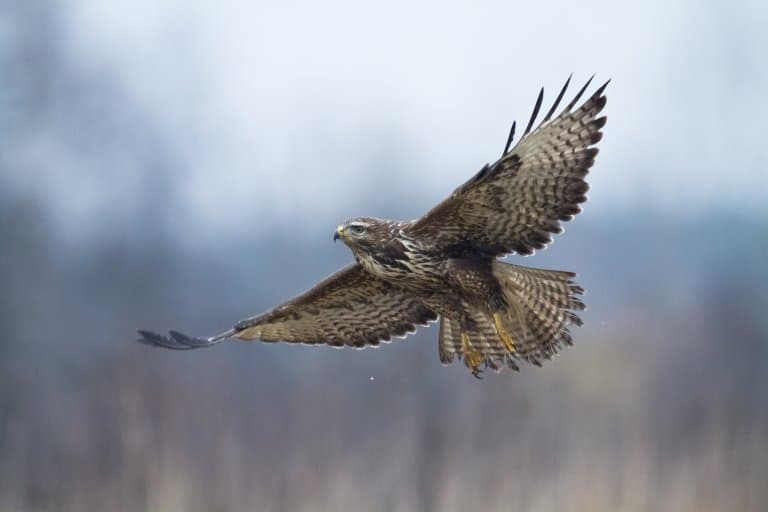
Common Buzzard Facts Overview
| Habitat: | Variety of different habitats including woodland, farmland and even cities |
| Location: | Most countries in Europe, also countries in Asia and Africa |
| Lifespan: | Average 8 years in the wild |
| Size: | 40 – 60cm height, 110 – 140cm wingspan |
| Weight: | Up to 1.4kg |
| Color: | Mostly brown with flecks of white the on chest and under the wings |
| Diet: | Rabbits and rodents, as well as insects, carrion and other bird species |
| Predators: | Eagles, foxes and wild cats |
| Top Speed: | Around 40 kph (25 mph) |
| No. of Species: |
1 |
| Conservation Status: |
Least Concern |
There are at least 7 subspecies of common buzzard, but there might be as many as 16. Each has small variations in mass, with larger birds found in colder climates.
They are commonly found in woodland and farmland habitats but can also thrive in towns and even cities, where enough trees and prey are present.
The common buzzard is an opportunistic carnivore and will hunt a huge variety of prey, especially when certain species are low in number. They are however primarily rodent hunters, most often observed catching rats, mice and voles.
Larger individuals will actively hunt prey as large as rabbits and all common buzzards will feed on insects, invertebrates and carrion when the opportunity presents itself. In countries such as Norway, the diet of the common buzzard contains a large proportion of reptiles, such as snakes and lizards and they will even kill and eat poisonous snakes, such as adders.
Common buzzards, like many birds of prey, use thermal air currents to glide and soar when hunting. They will often soar in circular patterns for long periods of time, using their excellent vision to scan the ground for potential prey.
When stationary in a tree, they can also use ambush hunting skills, especially when catching other birds such as crows. This usually occurs where birds congregate in large numbers, such as those feeding on animal carcasses, where the buzzard will swoop in and grab an unsuspecting bird as it feeds.
Buzzard nests are massive structures, built in tall trees or cliff faces. They are mainly built from sticks and branches and lined with soft leaves. Some nests can measure almost 2m across. The breeding pair will aggressively defend their territory once they have started building the nest and chase off other buzzards and even potential predators such as foxes that may be in the vicinity.
The common buzzard is classified as least concern by the ICUN, as they are the most common diurnal raptor in Europe, with a global population size in the millions.
Interesting Common Buzzard Facts
1. The common buzzard is the most common bird of prey in Europe
According to conservative estimations, Europe’s overall population is no less than 700,000 pairs.
This is double the number of the next most common bird, thought to be the the Eurasian sparrowhawk.
Global estimates of the common buzzard are between 2-4m!
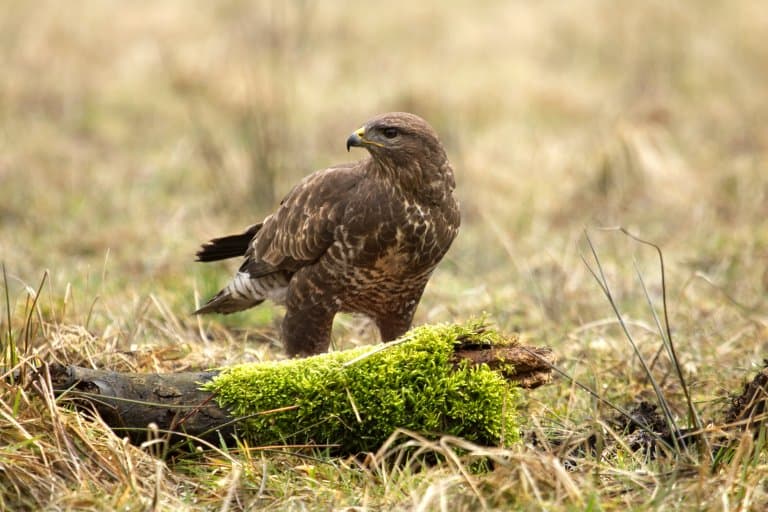
2. They are ‘partially migrant’
Most common buzzards in central Europe and British Isles remain in a location all year round. They might make small movements of up to 100km during the winter period.
However, during the harsh winter in their northern range, common buzzards migrate.
Some common buzzards migrate as far south as South Africa when temperatures drop drastically. 1
3. They have highly variable plumage
Although they are mainly brown with some white patches, some populations can be mostly white, while some appear to be completely brown. 2
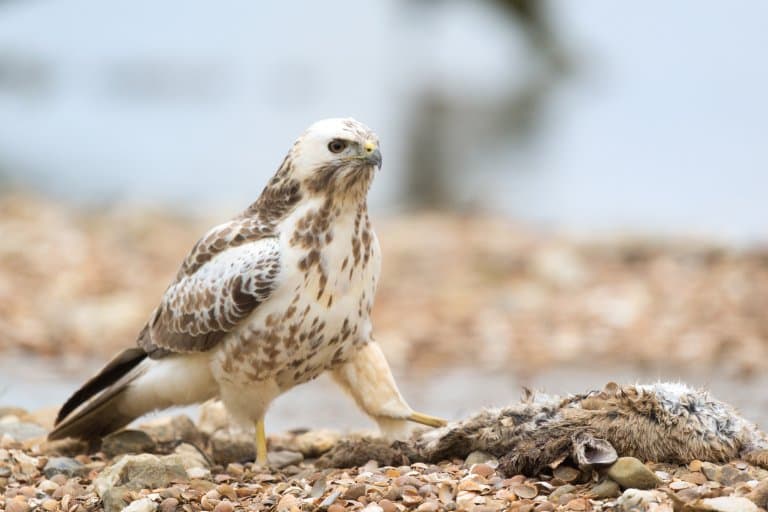
4. The common buzzard call is sometimes mistaken for a cat
One of their calls sounds distinctively like the meow of a cat.
5. They are solitary, but from time to time team up
Common buzzards are diurnal birds, hunting during the day and roosting in tall trees at night. They are mostly solitary animals outside of the breeding season, however some small flocks have been observed, usually in areas where prey is abundant.
There have even been reports of several buzzards working together to flush out rabbits and rodents, thereby increasing their hunting success rate. When a large animal carcass is found, large groups of buzzards may be seen feeding together, although some squabbling occurs between individuals.
6. When food is scarce, common buzzards will eat insects and invertebrates
During larger prey shortages, some buzzards will feed on invertebrates such as earthworms and beetles. 3
7. Common buzzards try to attract mates using superb aerial gymnastics
Buzzards will sometimes soar extremely high before rocketing down to earth and then soaring vertically upwards, hoping to impress a potential mate. 4

8. They are monogamous
Male and female common buzzards are typically monogamous and most remain with the same mate for life. Both birds help build the nest and they usually select an area with several nest site alternatives, which they utilise the following year.
Female common buzzards lay between 2-4 eggs each breeding season, usually as spring time approaches. When the chicks hatch the mother keeps them warm while the male hunts and brings back food for both the chicks and the mother.
As the chicks get older, both parents feed their quick-growing young and after just under two months the chicks are able to fly. For the following 2 months, the chicks stay with their parents, relying on them for food as they refine their own hunting skills.

9. Common buzzards can help control rodent and pigeon numbers
With extremely strong and sharp talons, most prey animals are killed within an instant after being grasped by a buzzard.
As well as catching rats and mice, common buzzards will also catch unwary pigeons either in flight or on the ground. 5
10. Common buzzards can kill and eat poisonous snakes
Some common buzzards kill and eat poisonous adders. 6
11. In America, the words ‘buzzards’ refers to a vulture
The turkey or black buzzards of North America are actually species of vultures.
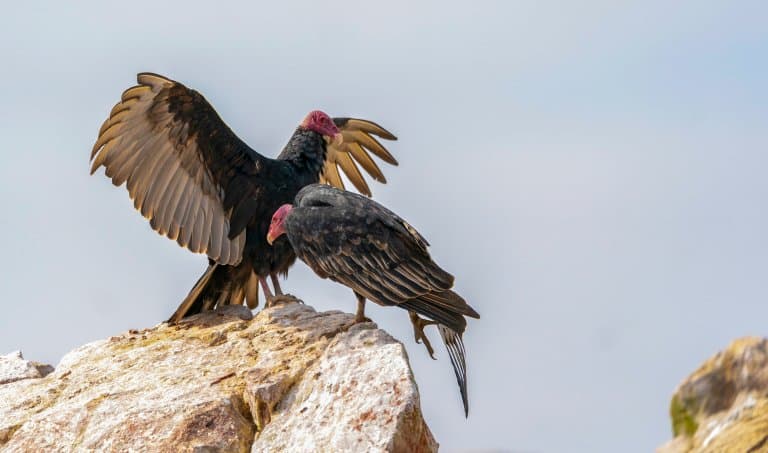
12. They are sometimes mistaken for eagles
Due to their large size and soaring ability, people sometimes think they have spotted an eagle, such as a golden eagle, rather than a buzzard.
13. Buzzards are hawks, and hawks are buzzards
Both these birds are members of the same genus, though hawks are usually smaller, slimmer birds.
14. They have made an incredible comeback in the UK
The common buzzard is now one of the most common and widespread raptors in Europe thanks to their high level of adaptability. In the early 20th century there were fewer than 1,000 breeding pairs remaining in their UK stronghold as a result of persecution and the use of pesticides in farming.
However they have since rebounded to around 70,000 breeding pairs in the UK and populations are increasing in other countries across their range.
As these large birds feed mainly on rodents, they play a vital role in controlling numbers and their presence is particularly beneficial to reducing rodent populations in farming areas.
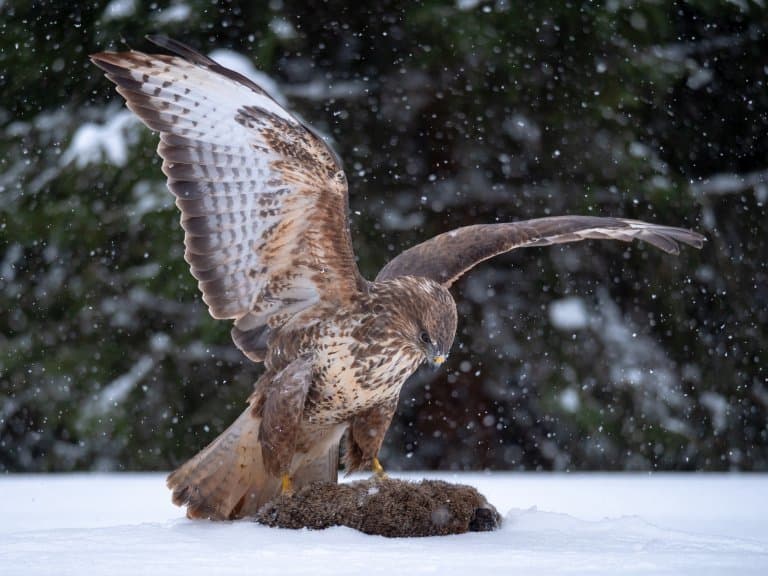
Common Buzzard Fact-File Summary
Scientific Classification
| Kingdom: | Animalia |
| Phylum: | Chordata |
| Class: | Aves |
| Order: | Accipitriformes |
| Family: | Accipitridae |
| Genus: | Buteo |
| Species Name: |
Buteo Buteo |
Fact Sources & References
- (1999), “buzzard”, Britannica.
- Ash (2023), “Common Buzzard (Buteo Buteo)”, Glenlivet Wildlife.
- Jakub Gryz (2019), “The Common Buzzard Buteo buteo Population in a Changing Environment, Central Poland as a Case Study”, MDPI.
- “Buzzard”, RSPB.
- “Eurasian Buzzard Buteo buteo”, Bird Life International.
- Vidar Selas (2001), “Predation on reptiles and birds by the Common Buzzard, Buteo buteo, in relation to changes in its main prey, voles”, Research Gate.
